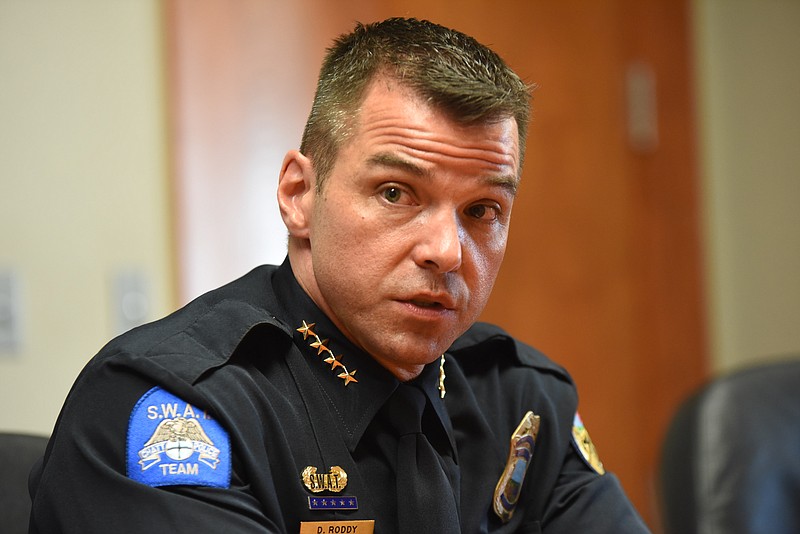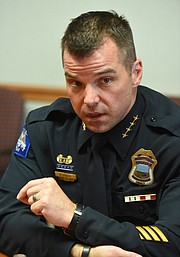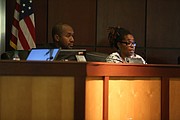The department Chattanooga Police Chief David Roddy envisions is one that uses technology, community relationships and focused deterrence to target individuals driving violent crime in the city.
On Monday afternoon, Roddy outlined his priorities to the Times Free Press, highlighting some of the department's key initiatives and methods, many of which have been implemented and tweaked over the last several years.
"If you look at what is shown, what research is showing to be effective, it is focused deterrence, it's community or problem-solving policing, and it's intelligence-led policing," he said. "Those are 30,000-foot umbrellas of how different initiatives, programs enforcement measures, community relations all develop under those."
He said fostering community support took on a heightened importance in the wake of an outside assessment of the department conducted before Fred Fletcher became became police chief three years ago.
The assessment identified some of the department's strengths and weaknesses and underscored the need for improved relations between the department and the people it serves.
"We asked ourselves how well we were dealing with the community, giving them what they needed on calls, how strong our relationships were and we thought we were doing a really good job with that. Some members of the community didn't think so," he said.
"That was probably one of the most impactful points of that survey."
Eric Tucker, assistant chief of the neighborhood policing bureau, confirmed Roddy's belief that residents are now more likely to step forward as witnesses and cooperate with police, at least partially because of the department's efforts to foster connections.
"Relationships are really a key component of being a good cop," Tucker said. "We try to build that bridge. We don't want to be seen as an adversary. We want to facilitate dialogue.
"I think our officers have fallen in line with that. I think they realize that is what community policing is about is building those relationships and being able to communicate with those in the neighborhood."
Roddy also touched on the Violence Reduction Initiative as an important element of the department's efforts to reduce crime.
One of Mayor Andy Berke's signature initiatives, in theory, relies on cooperation by police prosecutors and social services to crack down on violent offenders while assisting those who want out of that lifestyle through education and job training.
"The VRI is another tool in the focused deterrence toolbox, but it's not the only one we're going to use. The gun team is part of it. Other federal prosecutions are a part of it," he said.
"These are all what we consider to be collaborative law enforcement partnerships where we can address different things in a focused manner. It's not the broad net or we're going to go occupy East Chattanooga in order to drive down violence."
As part of that effort to dedicate resources efficiently, the department is also planning to add 14 sworn positions to staff a new gun unit and rapid response teams to handle shooting incidents. That staff expansion was the largest increased expense for personnel in the department's 2018 budget, which was approved earlier this month.
"We didn't know three years ago that we would be forming a team specifically dedicated to working on and tracking firearms violence, but under focused deterrence, it is an initiative that has come about."
The unit would utilize a five-person gun team and nine officers on response teams to follow up on dispatched calls about shots fired throughout the city as well as a ballistics database to connect firearms to the offenders who use them.
Chattanooga police also have come to depend on another massive technological investment - the real-time intelligence center. Analysts in that nerve center are able to look at footage from cameras that have been set up around the city in crime hot spots and direct the department's limited resources efficiently.
The center already has paid dividends, providing invaluable evidence in several cases since it went online earlier this year, said Edwin McPherson, assistant chief of the criminal investigations bureau.
"The real-time intelligence center definitely led us to the prosecution of a couple of people. We were able to immediately eliminate some of the offenders we thought may have been involved," he said.
"It's paid off, in my opinion, just on the several investigations that I'm aware of right now. It's been worth its weight in gold to us."
In June, the footage analyzed in the center led to the arrest of 28-year-old Lebron Brown, aka "2G," who allegedly shot multiple times into a van on Windsor Street, striking an 8-year-old boy in the abdomen.
Also of tantamount importance to Roddy is the need to build a department that reflects the diversity of the community it serves. He said one of the most recent police academy classes is 61 percent white, 25 percent black and 13 percent Latino, whereas previous classes were 75 to 85 percent white.
He said the department has begun to address that need, again, by building relationships with community members who otherwise might have dropped out or failed for one reason or another. In some cases, the answer has been as simple as tweaking physical standards that proved to be an unnecessary impediment.
"Not in my entire career have we hit those numbers. And that was because of direct reporting of minority and female applicants and working to figure out what's a testing level and what's a barrier, because they're not the same," he said. "We had been using pull-ups, but a majority of police departments don't even use pull-ups in their physical agility test, yet it had stayed part of ours."
But more than anything, he said, some of the largest improvements have been made, again, by building relationships in the community. Officers follow up with applicants and identify roadblocks that might be preventing graduation.
"The thing we've found that works the best for us is simply when you pick up a phone and say 'I want to know if you're still interested in being a Chattanooga police officer. I'd really like to see you in the next academy if you make it through the process.'" Roddy said. "People start showing up for tests after that."
He said those relationships that encourage young men and women to apply to the department and the relationships that build trust between residents and officers are integral to the Chattanooga Police Department's model.
"Our community supports us and we support them back. We are all together. I don't know that a week has gone by in however many years that some segment of Chattanooga's diverse community hasn't shown up to some way express support of its police department," Roddy said. "That's not something that just happens. It's something that we have to pay deliberate attention to to keep it healthy."
"While some communities may feel they need to do more, we just pledge to keep doing what we're doing, which is never forgetting that we're all in this together."
Contact staff writer Emmett Gienapp at egienapp@timesfreepress.com or 423-757-6731. Follow him on Twitter @emmettgienapp.


